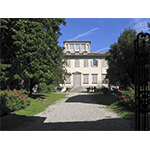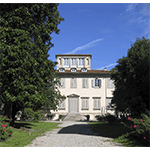Villa Bottini or Villa Buonvisi "al giardino"
Built by Bernardino Buonvisi in the second half of the 16th century, this splendid example of a stately urban villa is situated in an area with few other buildings but with many gardens, outside the San Gervasio gate of the medieval walls, and inside the renaissance walls of Lucca. A parallelepiped in shape, surmounted by a loggia-belvedere, the building has an elegant architectural design influenced by Ammannati and, for several of its decorations, by Buontalenti. The ground-floor interior and the portico are characterised by a fascinating fresco cycle with mythological and allegorical scenes by Ventura Salimbeni and his school in the last years of the 16th century. Particularly interesting is the Room of Sciences where the ceiling is frescoed with Poets and Scientists Guided to the Temple of Glory, the pendentives with the allegories of the Arts (Music, Arithmetic, Astrology and Geometry, Grammar, Rhetoric, Dialectics), and the lunettes with several illustrious figures, including Pythagoras, Dante, Aristotle, Archimedes, Asclepius.
The villa is surrounded by a rectangular-plan garden, enclosed by a high wall with three portals and a series of windows. The original layout presented a larger section subdivided into four beds. An unusual portal on the north side served – and still does – as the entrance to a nymphaeum reminiscent of Buontalenti, made up of a lawn surrounded by holm-oaks and a fountain against the boundary wall. The garden was so beautiful that the branch of the family that owned it was referred to as "Buonvisi al giardino". When in the early 19th century, it became property of Elisa Baciocchi, modifications were made to the garden layout, as well as to the villa. Today, the back of the garden is again divided into four beds by straight lanes with an octagonal pool at their point of intersection. Each bed has a circular pond in the middle and abounds in yews, horse chestnuts, magnolia, holm-oaks, planes and cedars of Lebanon. A lane divides the front of the garden into two areas with fountains surrounded by magnolias and conifers.
The villa is today property of the Commune of Lucca and headquarters of the Cultural Office.
****************************
Texts by Graziano Magrini
English translation by Victor Beard
Last update 25/gen/2008





